1996 PONTIAC GRAND-AM service schedule
[x] Cancel search: service schedulePage 3 of 356
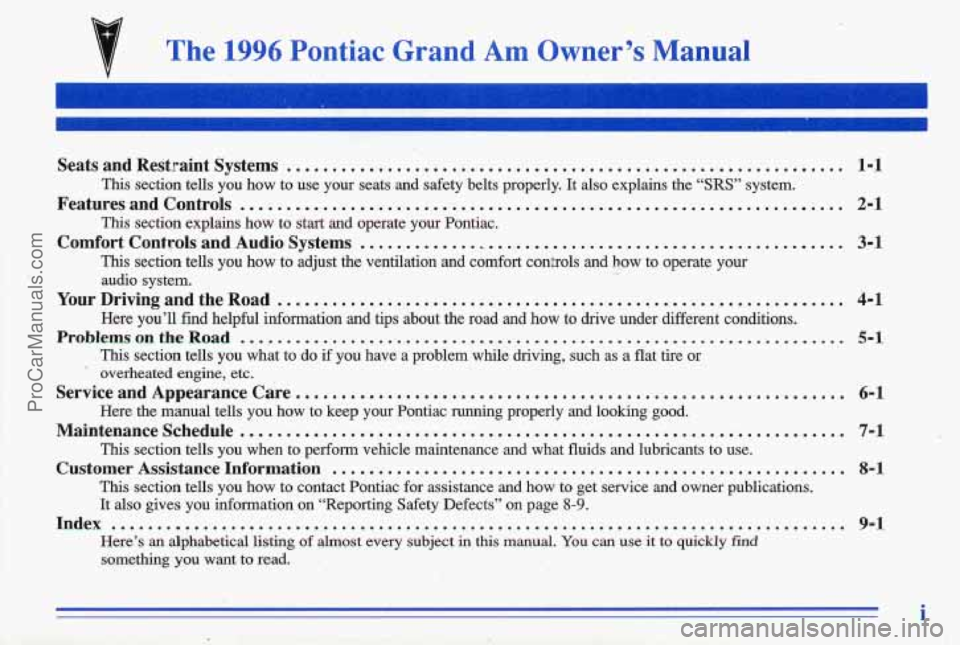
The 1996 Pontiac Grand Am Owner’s Manual
Seats and Restraint Systems ............................................................. 1-1
Features and Controls .................................................................. 2-1
Comfort Controls and Audio Systems ..................................................... 3-1
This section tells you how to use your seats and safety belts properly. It also explains the “SRS” system.
This section explains how to start and operate your Pontiac.
This section tells you how to adjust the ventilation
and comfort conkols and how to operate your
audio system.
Here you’ll find helpful information and tips about the road\
and how to drive under different conditions.
This section tells you what to do if you have a problem while driving, such as a flat tire or
Your Driving and the Road ............................................................... 4-1
ProblemsontheRoad .................................................................. 5-1
’ overheated engine, etc.
Service and Appearance Care ............................................................ 6-1
Maintenanceschedule.................................................... \
.............. 7-1 , ., ,(
Customer Assistance Information ........................................................ 8-1
Here the manual tells you how to keep your Pontiac running pr\
operly and looking good.
This section tells you when
to perform vehicle maintenance and what fluids and lubricants to use.
This section tells you how to contact Pontiac for assistance and how to get serv\
ice and owner publications.
It also gives you information on “Reporting Safety Defects” o\
n page
8-9.
Here’s an alphabetical listing of almost every subject in this manual. You can use it to quickly find
something you want to read.
Index ........................................................................\
........ 9-1
i
ProCarManuals.com
Page 188 of 356
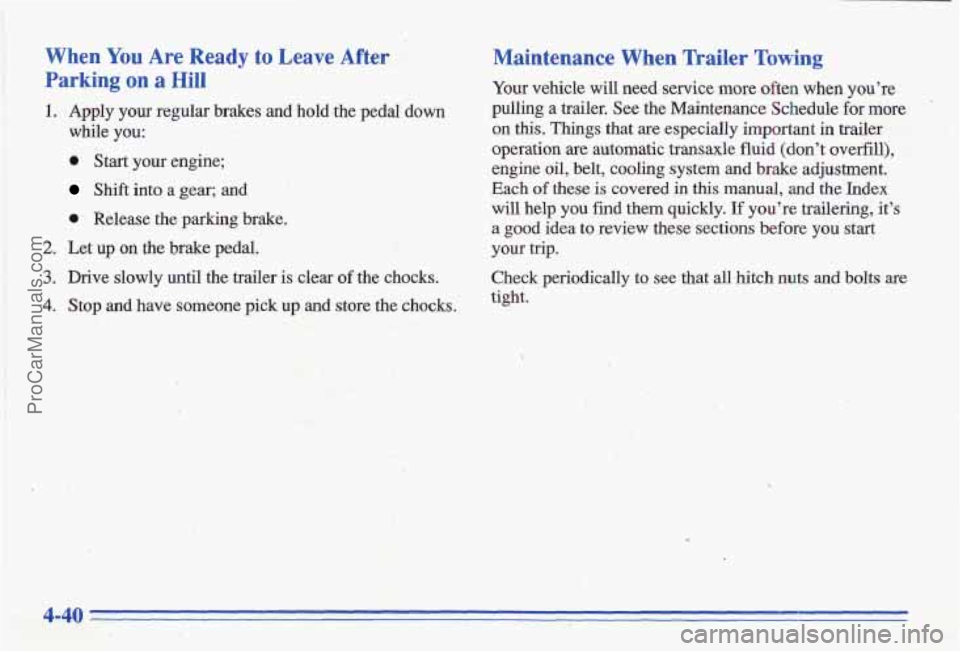
When You Are Ready to Leave After
Parking on a Hill
1. Apply your regular brakes and hold,the pedal down
while
you:
0 Start your engine;
Shift into a gear; and
I. Release the parking brake.
2. Let up on the brake pedal..
3. Drive slowly until the trailer is clear of the chocks.
4. Stop and have someone pick up and store the chocks.
Maintenance When Trailer Towing
Your vehicle will need service more often when you're
pulling a trailer. See the Maintenance Schedule for more
on this. Things that are especially important in trailer
operation are automatic transaxle
fluid (don't ovel-fill),
engine oil, belt, cooling system and brake adjustment.
Each of these is covered in this manual, and the Index
will
help you find them quickly. If you're trailering, it's
a good idea to review these sections before you start
<* ~ I ,,; ;-':'. .a t , ,--: .. ;::l.$.:$ 5
Check periodically to see that all hitch nuts and bolts are
tight.
your trip. ! . .i . :$ ,,- .,,. . . f ~
_I.,
4-40
ProCarManuals.com
Page 238 of 356
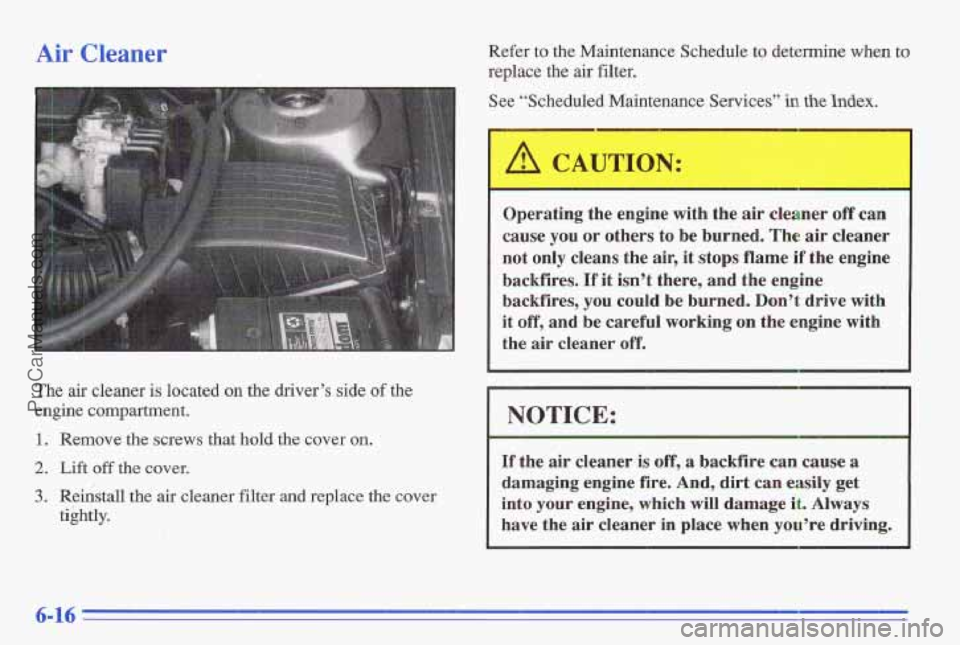
Air Cleaner
The air cleaner is located on the driver’s side of the
engine compartment.
1. Remove the screws that hold the cover on.
2. Lift off the cover.
3. Reinstall the air cleaner fi
tightly. lter
and replace
the cover Refer to the Maintenance Schedule to determine when to
replace the air filter.
See “Scheduled Maintenance Services”
in the Index.
Operating the engine with the air cleaner off can
cause
you or others to be burned, The air cleaner
not only cleans the air, it stops flame if the engine
backfires.
If it isn’t there, and the engine
backfires,
you could be burned. Don’t drive with
it off, and be careful working on the engine with
the air cleaner off.
I NOTICE:
If the air cleaner is off, a backfire can cause a
damaging engine fire. And, dirt can easily get
into your engine, which will damage it. Always
have the air cleaner in place when you’re driving.
6-16
ProCarManuals.com
Page 239 of 356
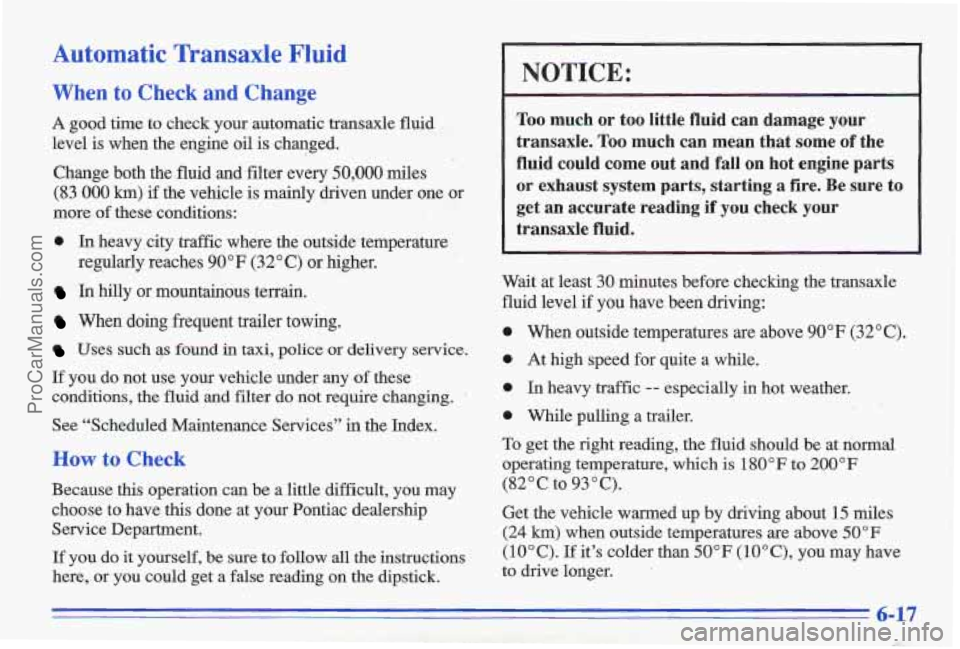
Automatic Transaxle Fluid
When to Check and Change
A good time to check your automatic transaxle fluid
level is when the engine oil is changed.
Change both the fluid and filter every
50,000 miles
(83 000 km) if the vehicle is mainly driven under one or
more of these conditions:
0 In heavy ,city traffic where the outside, temperature
In hilly or mountainous terrain.
When doing frequent trailer towing.
Uses such zp found in taxi, police or delivery service.
If you do not use your vehicle under any of these
conditions, the fluid and
filter do not require changing.
See “Scheduled Maintenance Services”
in the Index.
How to Check
Because this operation can be a little difficult, you may choose to have this done at your Pontiac dealership Service Department.
If you do it yourself, be sure to follow all the instructions
here, or
you could get a false reading on the dipstick.
regularly reaches
90°F (32°C)
or higher.
NOTICE:
Too much or too little fluid can damage your
transaxle.
Too much can mean that some of the
fluid could come out and fall on hot engine parts
or exhaust system parts, starting a fire. Be sure to
get an accurate reading if you check your
transaxle fluid.
Wait at least 30 minutes before checking the transaxle
fluid level
if you have been driving:
0 When outside temperatures are above 90°F (32°C).
0 At high speed for quite a while.
0 In heavy traffic -- especially in hot weather.
0 While pulling a trailer.
To get the right reading, the fluid should be at normal
operating temperature, which
is 180°F to 200°F
(82°C to 93°C).
Get the vehicle warmed up by driving about 15 miles
(24 krn) when outside temperatures are above 50°F
(10°C). If it’s colder than 50°F (lO°C), you may have
to drive longer.
ProCarManuals.com
Page 244 of 356
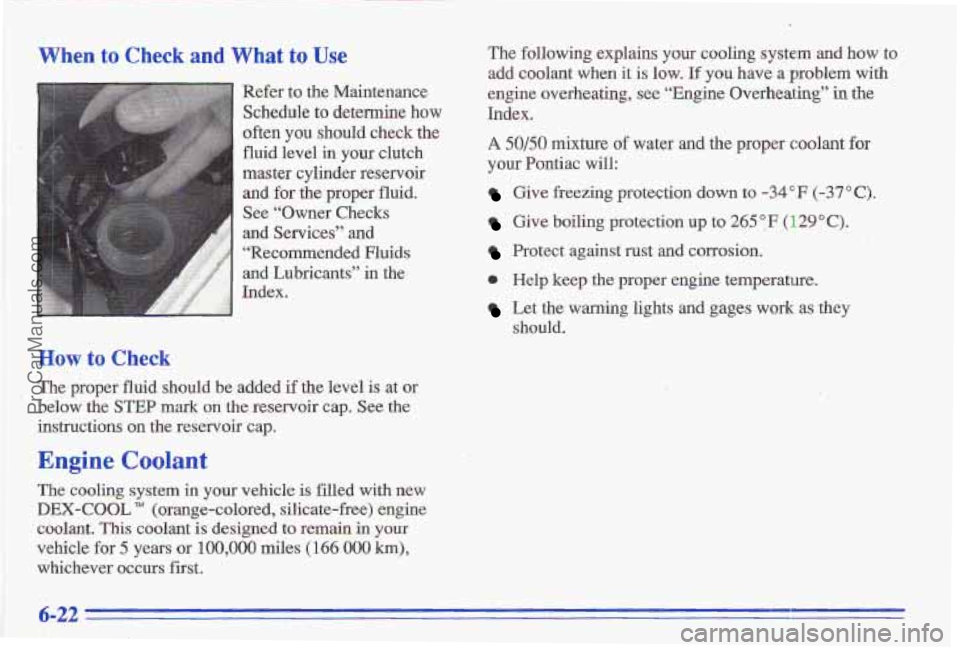
When to Check and What to Use
Refer to the Maintenance
Schedule
to determine how
often you should check the
fluid level
in your clutch
master cylinder reservoir and for
the proper fluid.
See “Owner Checks
and Services” and
“Recommended Fluids
and Lubricants” in the
How tu Check
The proper fluid should be added if the level is at or
below the
STEP mark on the reservoir cap. See the
instructions
on the reservoir cap.
Engine Coolant
The cooling system in your vehicle is filled with new
DEX-COOL TM (orange-colored, silicate-free) engine
coolant.
This coolant is designed to remain in your
vehicle
for 5 years or 100,000 miles (166 000 h),
whichever occurs first. The
following explains
your cooling system and how to
add coolant when it is low. If you have a problem with
engine overheating, see “Engine Overheating”
in the
Index.
A Sol50 mixture of water and the proper coolant for
your Pontiac will:
Give freezing protection down to -34°F (-37°C).
Give boiling protection up to 265 9 F ( 129 O C).
Protect against rust and corrosion.
0 Help keep the proper engine temperature.
Let the warning lights and gages work as they
should.
6-22
ProCarManuals.com
Page 261 of 356

Tire Inspection and Rotation
Tires should be inspected every 6,000 to 8,000 miles
(10 000 to 13 000 km) for any signs of unusual wear.
If unusual wear is present, rotate your tires as soon as
possible and check wheel alignment. Also check for damaged tires or wheels. See “When It’s Time for New
Tires” and “Wheel Replacement” later in this section for
more information. When rotating your tires, always use the correct rotation
pattern shown here.
Don’t include
the compact.spa.re tire in your tire
rotation.
After the tires have been rotated, adjust the front and
rear inflation pressures as shown on the Tire-Loading
Information label. Make certain that all wheel nuts are
properly tightened. See “Wheel Nut Torque” in the
Index.
I
The purpose of regular rotation is to achieve more
uniforrn wear for all tires on the vehicle. The first
rotation is the most important. See “Scheduled Maintenance Services”
in the Index for scheduled
rotation intervals.
--
Rust or dirt on a wheel, lr on the part D which
it is fastened, can make wheel nuts become loose
after
a time. The wheel could come off and cause
an accident. When
you change a wheel, remove
any rust or- dirt from places where the wheel
attaches to the vehicle. In an emergency,
you can
use
a cloth or a paper towel to do this; but be
sure to use
a scraper or wire brush later, if you
need to, to get all the rust or dirt off. (See
“Changing
a Flat Tire” in the ‘Index.)
6-39
ProCarManuals.com
Page 285 of 356
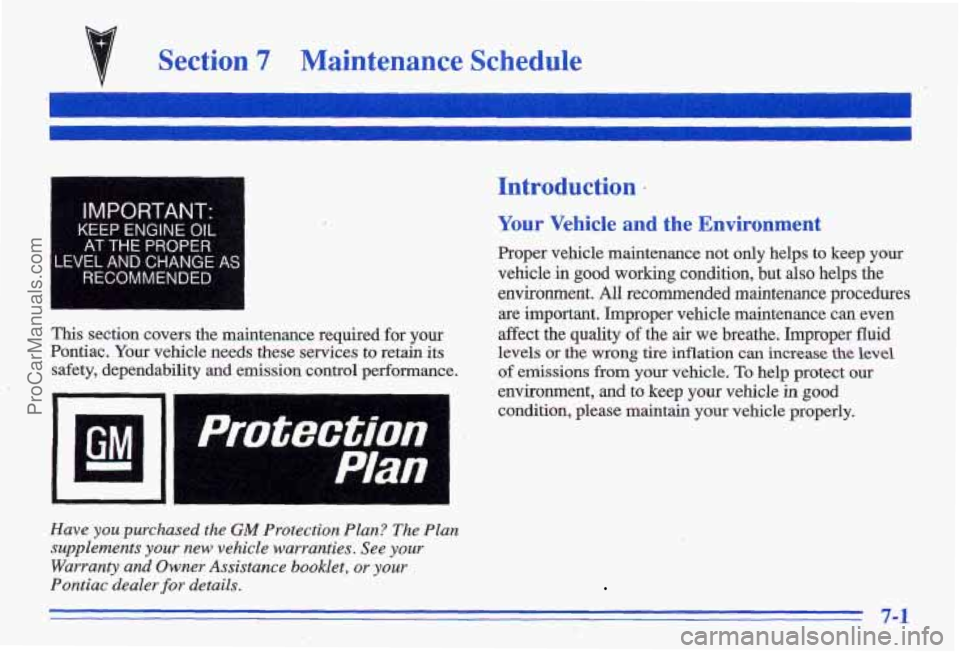
v Section 7 Maintenanc,e Schedule - -.
IMPORTANT-
KEEP ENGINE OIL
AT THE PROPER
.EVEL AND CHANGE AS
RECOMMENDED
Introduction
Your Vehicle and the Environment
Proper vewcle maintenance not only helps to keep your
vehicle in good working condition, but also helps the
environment. All recommended maintenance procedures
are important. Improper vehicle maintenance can even
~ This section covers the maintenance required for your affect the quality of the air we breathe. Improper fluid
Pontiac. Your vehicle needs
these services to retain its levels or the wrong tire inflation can increase the level
safety, dependability and emission control performance. of emissions from your vehicle. To help protect our
..
'. 2 ,
Have you purchased the GM Protection Plan? The Plan
supplements your new vehicle warranties. See your
Warranty and Owner Assistance booklet, or your
Pontiac dealer for details. .- ,! .- .. .. .. .. 1' . '>.. 3 , .. -. ., . -b . ' .: : I .6.
7-1
ProCarManuals.com
Page 286 of 356
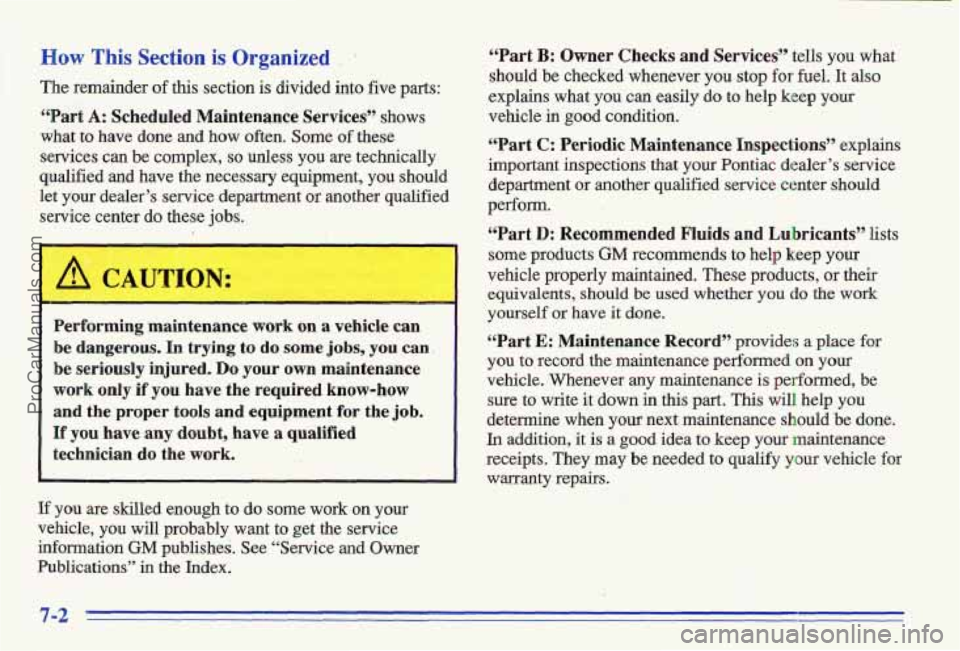
How This S
The remainder
lection is Organized , . LLPart B: Owner Checks and Services” tells you what
of this section is divided into five parts: should be checked whenever you stop for fuel. It also
explains what you can easily do to help keep
your
“Part A: Scheduled Maintenance Services” shows vehicle in good condition.
what to have done
and how often. Some ‘of these
services
can be complex, so unless you are technically
let your dealer’s service department or another qualified pefiom.
service center do these jobs.
LLPart C: Periodic Maintenance Inspections” explains
important inspections that your Pontiac dealer’s service
qualified
and have the You department or mother qualified semice center should
‘(Part D: Recommended Fluids and Lubricants” lists
some products GM recommends to help keep your
vehicle properly maintained. These products, or their equivalents,
should be used whether you do the work
yourself or have it done.
Performing maintenance work on a vehicle can
be dangerous. In trying to
do some jobs, YOU can. “Part E: Maintenance Record” provides a place for
be seriously injured. Do your own maintenance you to record the maintenance performed on your
work only if you have the required know-how vehicle. ‘Whenever any maintenance is performed, be
sure to write it down
in this part. This will help you and the proper tools and equipment for the job. determine when your next maintenance should be done.
If you have any doubt, have a qualified In addition, it is a good idea to keep your maintenance
technician do the work. receipts. They may be needed to.qualify your vehicle for
1’ -
warranty repairs.
If you are skilled enough to do some work on your
vehicle, you will probably want to get the service information
GM publishes. See “Service and Owner
Publications”
in the Index.
7-2
ProCarManuals.com